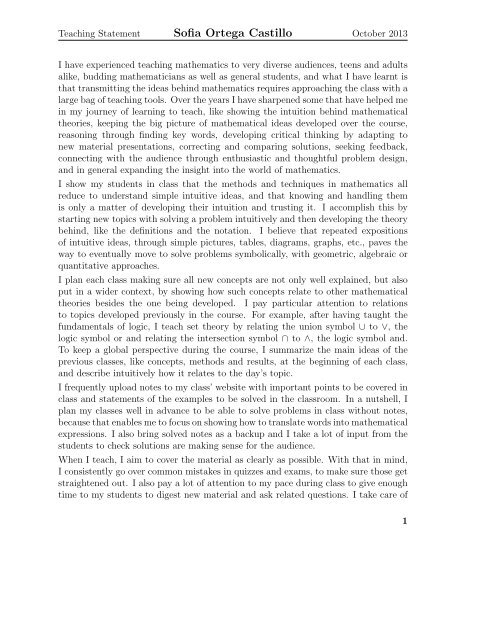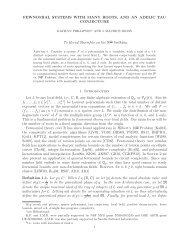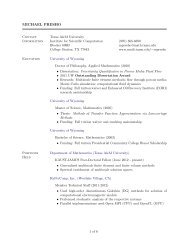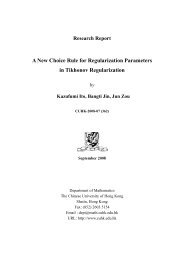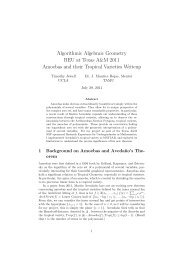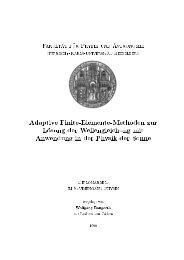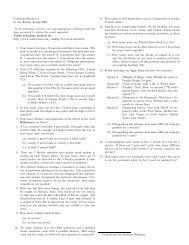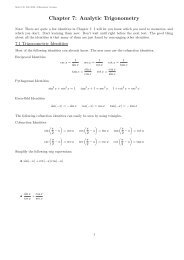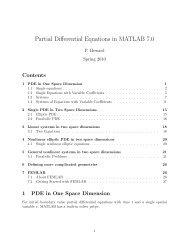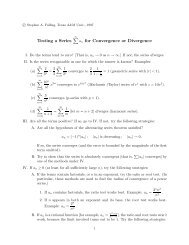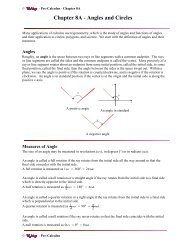Philosophy of Teaching Statement
Philosophy of Teaching Statement
Philosophy of Teaching Statement
Create successful ePaper yourself
Turn your PDF publications into a flip-book with our unique Google optimized e-Paper software.
<strong>Teaching</strong> <strong>Statement</strong> S<strong>of</strong>ia Ortega Castillo October 2013<br />
I have experienced teaching mathematics to very diverse audiences, teens and adults<br />
alike, budding mathematicians as well as general students, and what I have learnt is<br />
that transmitting the ideas behind mathematics requires approaching the class with a<br />
large bag <strong>of</strong> teaching tools. Over the years I have sharpened some that have helped me<br />
in my journey <strong>of</strong> learning to teach, like showing the intuition behind mathematical<br />
theories, keeping the big picture <strong>of</strong> mathematical ideas developed over the course,<br />
reasoning through finding key words, developing critical thinking by adapting to<br />
new material presentations, correcting and comparing solutions, seeking feedback,<br />
connecting with the audience through enthusiastic and thoughtful problem design,<br />
and in general expanding the insight into the world <strong>of</strong> mathematics.<br />
I show my students in class that the methods and techniques in mathematics all<br />
reduce to understand simple intuitive ideas, and that knowing and handling them<br />
is only a matter <strong>of</strong> developing their intuition and trusting it. I accomplish this by<br />
starting new topics with solving a problem intuitively and then developing the theory<br />
behind, like the definitions and the notation. I believe that repeated expositions<br />
<strong>of</strong> intuitive ideas, through simple pictures, tables, diagrams, graphs, etc., paves the<br />
way to eventually move to solve problems symbolically, with geometric, algebraic or<br />
quantitative approaches.<br />
I plan each class making sure all new concepts are not only well explained, but also<br />
put in a wider context, by showing how such concepts relate to other mathematical<br />
theories besides the one being developed. I pay particular attention to relations<br />
to topics developed previously in the course. For example, after having taught the<br />
fundamentals <strong>of</strong> logic, I teach set theory by relating the union symbol ∪ to ∨, the<br />
logic symbol or and relating the intersection symbol ∩ to ∧, the logic symbol and.<br />
To keep a global perspective during the course, I summarize the main ideas <strong>of</strong> the<br />
previous classes, like concepts, methods and results, at the beginning <strong>of</strong> each class,<br />
and describe intuitively how it relates to the day’s topic.<br />
I frequently upload notes to my class’ website with important points to be covered in<br />
class and statements <strong>of</strong> the examples to be solved in the classroom. In a nutshell, I<br />
plan my classes well in advance to be able to solve problems in class without notes,<br />
because that enables me to focus on showing how to translate words into mathematical<br />
expressions. I also bring solved notes as a backup and I take a lot <strong>of</strong> input from the<br />
students to check solutions are making sense for the audience.<br />
When I teach, I aim to cover the material as clearly as possible. With that in mind,<br />
I consistently go over common mistakes in quizzes and exams, to make sure those get<br />
straightened out. I also pay a lot <strong>of</strong> attention to my pace during class to give enough<br />
time to my students to digest new material and ask related questions. I take care <strong>of</strong><br />
1
<strong>Teaching</strong> <strong>Statement</strong> S<strong>of</strong>ia Ortega Castillo October 2013<br />
making my students comfortable to ask questions by being very respectful, open and<br />
friendly, and by thanking their participation.<br />
Since I care about my classes being well understood, I also give review lessons, and<br />
change the notation over those to test if the ideas behind are grasped well enough to<br />
handle different presentations <strong>of</strong> the same material, or otherwise I give more examples.<br />
I seek to develop some critical thinking in my students, therefore my exams usually<br />
include a number <strong>of</strong> work out problems to test it.<br />
Seeking to meet my students’ needs also outside <strong>of</strong> the classroom, I publish online all<br />
solutions to exams, quizzes and problems worked in class, so that they may be able<br />
to work them out on their own if necessary, and may be able to compare solutions. I<br />
also make sure to answer all questions in class and through email, and I make myself<br />
available for <strong>of</strong>fice hours.<br />
<strong>Teaching</strong> adequately is challenging, thus I seek feedback from my students on teaching<br />
performance through a mid-semester anonymous survey to adjust my teaching<br />
methods to their needs. I also communicate with fellow teachers to find solutions to<br />
challenges in teaching.<br />
During my undergraduate years, I engaged in weekly sessions <strong>of</strong> informal instruction<br />
for the Mexican Mathematical Olympiad, teaching students from elementary school<br />
to high school, and with diverse levels <strong>of</strong> interest in mathematics. What I have learnt,<br />
is that I want my general students to take from my classes a broad understanding and<br />
insight into the mathematics we encounter every day, and I want to provide them with<br />
the knowledge <strong>of</strong> the tools that help solve such basic math problems. To audiences<br />
<strong>of</strong> mathematicians, I want to transmit a desire for learning a language <strong>of</strong> abstract<br />
thinking and an art <strong>of</strong> abstract problem-solving.<br />
2


